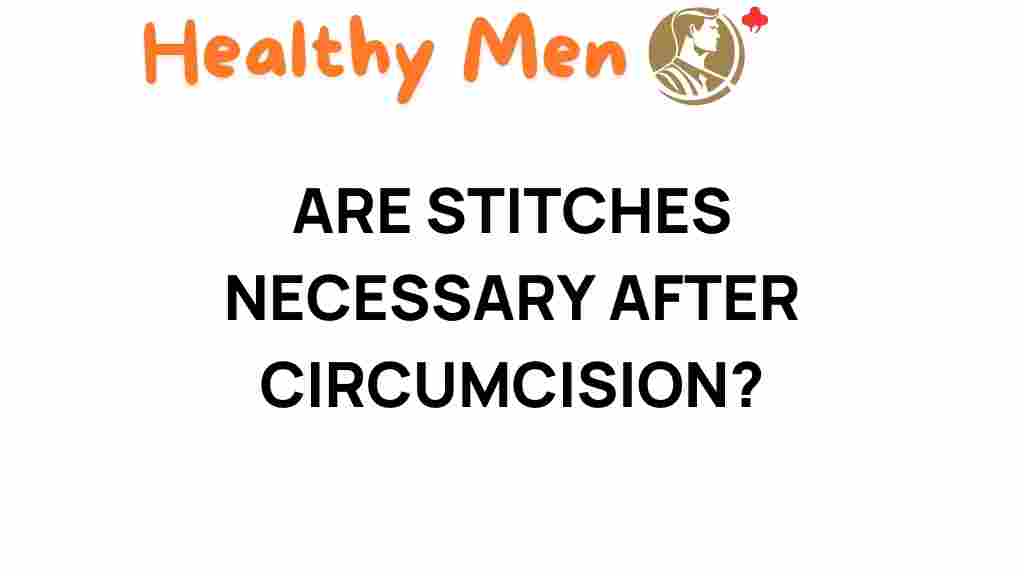Do You Need Stitches After Circumcision?
Circumcision is a common surgical procedure that involves the removal of the foreskin from the penis. This procedure can be performed on infants, children, and adults for various medical and cultural reasons. One of the frequently asked questions surrounding circumcision is whether stitches are necessary after the procedure. In this article, we will unpack the myths surrounding circumcision, stitches, and recovery while ensuring that we provide accurate information for parents and caregivers.
Understanding Circumcision
Circumcision is performed for several reasons, including:
- Religious beliefs
- Cultural practices
- Medical conditions, such as phimosis or recurrent infections
Regardless of the reasons, understanding the implications of the procedure, including the use of stitches and recovery processes, is essential for ensuring safety and comfort for the infant or child.
Do You Need Stitches After Circumcision?
The necessity for stitches after circumcision largely depends on the technique used by the healthcare provider. Here’s a breakdown:
- Traditional Circumcision: In many cases, stitches are required to close the incision after removing the foreskin. These stitches may be absorbable, meaning they dissolve on their own, or non-absorbable, which would require a follow-up appointment for removal.
- Clamp Techniques: Some modern circumcision methods use a clamp that minimizes bleeding and eliminates the need for stitches. These techniques can reduce recovery time and discomfort.
Ultimately, it is crucial to discuss with your healthcare provider what method will be used and whether stitches will be involved in your child’s circumcision.
The Procedure: What to Expect
Circumcision is typically performed in a sterile environment, and the process can be broken down into several steps:
- Preparation: The area is cleaned, and anesthesia is administered to ensure the infant feels no pain during the procedure.
- Removal of the Foreskin: The foreskin is carefully removed using the chosen technique, whether traditional or clamp.
- Closure: If stitches are required, the healthcare provider will close the incision. If using a clamp technique, the clamp will remain in place for a few days.
- Post-Procedure Care: Parents will receive instructions on how to care for the circumcised area during recovery.
Recovery After Circumcision
Recovery after circumcision is an essential aspect of the procedure. Here are some general guidelines:
- Pain Management: Over-the-counter pain relievers may be recommended for infants to manage discomfort. Consult your healthcare provider for the appropriate dosage.
- Hygiene: Keeping the area clean is crucial. Use gentle cleansing methods, and avoid using baby wipes with alcohol or fragrances.
- Observation: Monitor the area for any signs of infection, such as increased redness, swelling, or discharge.
- Follow-Up: Schedule follow-up appointments to ensure proper healing and, if applicable, to remove non-absorbable stitches.
Common Myths About Circumcision and Stitches
Several myths surround circumcision and the use of stitches. Let’s clarify some of these misconceptions:
- Myth 1: All circumcisions require stitches. While traditional methods usually involve stitches, some modern techniques do not.
- Myth 2: Stitches are always painful. While there may be some discomfort, stitches are placed under anesthesia, and absorbable stitches typically cause minimal pain once they dissolve.
- Myth 3: Complications are common after circumcision. While complications can occur, they are relatively rare when the procedure is performed by a qualified healthcare provider. Risks include bleeding, infection, and improper healing.
Post-Procedure Troubleshooting Tips
After the circumcision, parents may encounter some issues. Here are troubleshooting tips for common concerns:
- Excessive Bleeding: If you notice continuous bleeding, apply gentle pressure to the area and contact your healthcare provider immediately.
- Signs of Infection: If the area becomes increasingly red, swollen, or emits an odor, seek medical advice.
- Pain Management: If over-the-counter pain relief is insufficient, consult your doctor for stronger options.
Safety Considerations
Ensuring safety during and after the circumcision procedure is paramount. Here are some important safety tips:
- Choose a Qualified Healthcare Provider: Always ensure that the procedure is performed by a licensed and experienced professional.
- Follow Post-Care Instructions: Adhere strictly to the aftercare protocols provided by your healthcare provider.
- Monitor for Complications: Be vigilant for any abnormal signs that may require medical attention.
Conclusion
Understanding whether stitches are necessary after circumcision is crucial for parents considering this procedure for their child. While traditional circumcision typically involves stitches, modern techniques may not require them, which can impact recovery and care practices. By dispelling common myths and providing accurate information, we aim to empower parents to make informed decisions about circumcision and ensure a safe recovery process.
For more information on circumcision and related healthcare topics, visit this resource. If you have further questions or concerns, always consult your healthcare provider for personalized advice.
Remember, informed decisions lead to better outcomes in infant care and overall healthcare safety.
This article is in the category Conditions and created by healthymen Team
